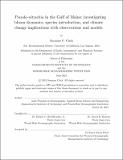Pseudo-nitzschia in the Gulf of Maine: investigating bloom dynamics, species introduction, and climate change implications with observations and models
Author(s)
Clark, Suzanna C.
DownloadThesis PDF (17.54Mb)
Advisor
Ralston, David K.
Terms of use
Metadata
Show full item recordAbstract
The apparent global increase in harmful algal blooms (HABs) includes Pseudo-nitzschia blooms in the Gulf of Maine, where shellfishery closures can cost millions of dollars. Temperatures in the gulf are warming, which can affect the severity of some HABs. Yet Pseudo-nitzschia in the region are understudied.
Pseudo-nitzschia bloom dynamics, P. australis introduction, and potential future changes thereof were investigated in the Gulf of Maine. Data from ship surveys and moorings were used, as well as
hydrodynamic, climate, and Lagrangian particle tracking models. Pseudo-nitzschia bloom toxicity was driven primarily by species composition, not environmental factors. P. australis was introduced to the region in 2016 via a coastal current from the Scotian Shelf. Climate change might intensify Pseudo-nitzschia blooms, shift bloom timing
1–2 weeks earlier in the spring or 4–6 weeks later in the fall, or lengthen the growing season by 3 weeks. It might also affect species composition and connectivity within the gulf. This work has implications for the monitoring of current and future blooms in the
Gulf of Maine and for our understanding of HAB introduction to the region. It can also be used to develop predictive models for Pseudo-nitzschia, which could be applied to other HABs.
Date issued
2021-06Department
Massachusetts Institute of Technology. Department of Earth, Atmospheric, and Planetary SciencesPublisher
Massachusetts Institute of Technology